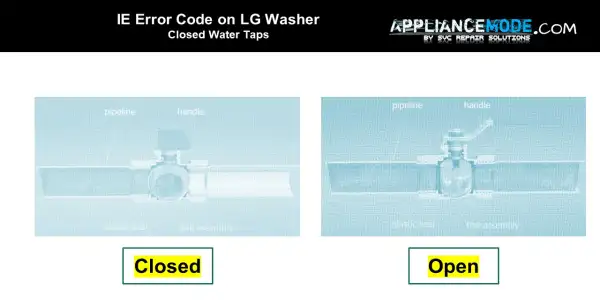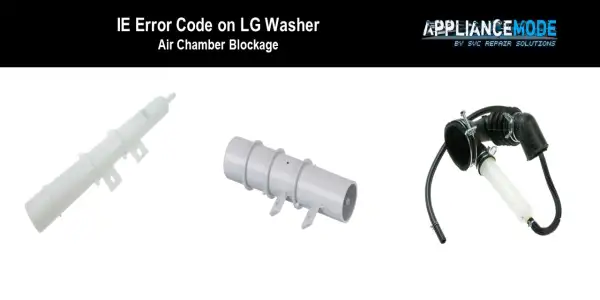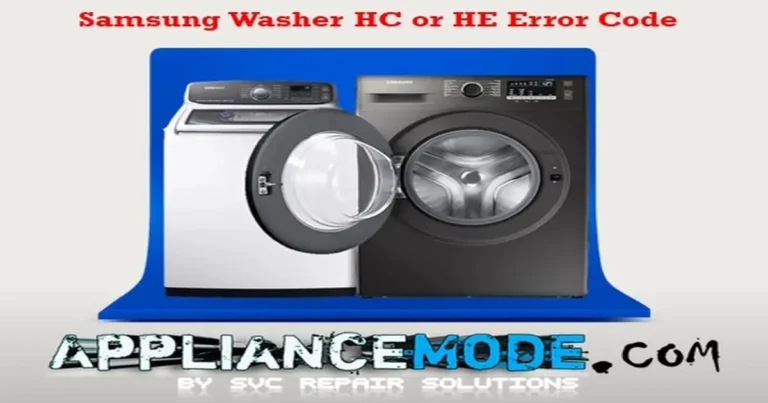Hey there! In this blog post, we’ll be discussing the LG washing machine IE error code. Whether you’re using an LG front-load washer or a top-load washer, this post is perfect for you.

We’ll show you how to handle an IE error code, what the error means, its causes, and how to troubleshoot or fix it effectively. So, let’s jump right in and learn how to fix the LG washing machine IE error code!
Diving into the LG Washing Machine IE Error Code: Meaning, Causes, and Troubleshooting
The IE error code, also sometimes displayed as 1E, on your LG washing machine is a clear signal that there’s an issue with the water inlet valve. Essentially, IE code stands for “Inlet Error,” which translates to your washer encountering a bit of trouble when trying to fill up with water during either the wash or rinse cycle.
If your washer stumbles upon issues in getting water where it needs to be, the IE error code will pop up to let you know something’s up.
Exploring the Factors Behind Water Inlet Woes
Let’s break down these contributing factors to the IE error code:
- If the water supply faucets connected to your washing machine aren’t fully open or closed, or if there’s low water pressure in your area, your washer might struggle to get the necessary amount of water. This could lead to the IE error code as the machine can’t fill up adequately.

- In regions with colder temperatures, water lines have the potential to freeze, resulting in a blockage of water flow to the washing machine. This lack of water reaching the machine triggers the IE error code.
- If the hoses responsible for delivering water to the machine are bent, twisted, or squeezed in any way, it obstructs the water flow. This blockage prompts the IE error code.
- Over time, the water inlet filters can accumulate debris and sediment from the water supply. When these filters become clogged, water flow is restricted, leading to the IE error code.
- Some customers use flood-safe hoses that contain mechanisms to automatically shut off water flow in case of leaks. However, these mechanisms can sometimes malfunction and mistakenly restrict water flow, resulting in the IE error.
- The wire connections between the water inlet valve and the main control board can deteriorate or become loose. This disrupted communication can trigger the IE error as the machine struggles to understand water input signals.
- If the water inlet valve remains stuck open, the machine might keep filling with water beyond the required level. This excess water can trigger the IE error code.
- The air chamber and pressure switch hose in your washer work together to monitor and regulate water levels. If the air chamber becomes clogged or the pressure switch hose contains a pinhole, it can’t accurately sense water levels, leading to the IE error.
- A malfunctioning main board can misinterpret signals related to water intake and trigger the IE error code.
Each of these factors can disrupt the water flow or communication within your washing machine, causing it to encounter difficulties in managing water intake during the wash and/or rinse cycles, which is what ultimately triggers the IE error code.
Navigating the IE Error Code on LG Washers: Practical Solutions for Common Water Inlet Challenges
Always prioritize safety before attempting any repair.
If you come across the IE error code on your LG washing machine, follow these steps to troubleshoot and resolve the issue:
- Ensure that the water supply faucets are fully open and provide adequate water pressure to the machine. If the pressure is low, consider addressing the water pressure issue in your area.
- If you’re in a colder climate and suspect frozen water lines, allow them to thaw before using the machine. You might need to warm up the area around the water lines or wait until the temperature rises.
- Examine the water inlet hoses for any kinks, twists, pinches, or crushes. Straighten out any obstructions to ensure smooth water flow.
- If your machine has water inlet filters, remove and clean them to remove any accumulated debris. This will improve water flow and prevent clogs.
- If flood-safe hoses are causing the issue, consider replacing them with standard hoses to ensure proper water flow without unnecessary restrictions.
- Inspect the wire harness between the water inlet valve and the main control board. Ensure all connections are secure and free from damage.
- If the water inlet valve is faulty or stuck open, consider replacing it to regulate water flow accurately.
- If the pressure switch hose contains a pinhole or the air chamber is clogged, clean or replace them to restore proper water level sensing.

Cracking the LG Washer IE Error Code: Advanced Troubleshooting and Proven Solutions, Including Voltage and Resistance Checks
- Start by unplugging the washing machine to ensure safety during the troubleshooting process.
- Inspect the harness connections both at the water valves and the main board. Make sure they are securely connected and free from damage.
- Disconnect the harness connections from the water valves and test the resistance of each valve. The resistance values should be approximately 0.8 KΩ | 1.2 KΩ @ 120 Vac and 3.4 KΩ | 4.1 KΩ @ 220 Vac, or 26 Ω | 32 Ω @ 12 Vdc. If you find an open circuit, it’s an indication to replace the faulty valve.

- After reconnecting everything, plug in the washing machine and activate the test mode. This mode will cycle through all water valves, allowing you to check their functionality.
- While in test mode, measure the voltage at the water valves. It should read 120 Vac or 220 Vac (or 12 volts for DC valves). If you don’t detect any voltage, proceed to the next step.
- If there’s no voltage detected at the water valves, check the voltage at the main board. If there’s still no voltage present, it might be necessary to replace the main board.
Keep in mind that the voltage readings [120 Vac or 220 Vac] can vary depending on the regions where washing machines are sold.
Conclusion:
Tackling the IE error code on your LG washing machine might seem daunting, but armed with the right knowledge and troubleshooting steps, you’re well-equipped to overcome this challenge. By understanding the factors behind the error and performing thorough checks on the water supply, valves, harness connections, and even voltage readings, you can find and fix the issue step by step. Remember, safety always comes first. So, fear not the IE code—you’ve got this!
Clearing Up LG Washing Machine IE Error Code: FAQs for Resolving Water Inlet Issues on LG Washers

I am a master Appliance Repair technician with over 35 years of experience in the field. I am passionate about helping people troubleshoot their appliances and fix common problems. My website, appliancemode.com, provides a wealth of information on troubleshooting common appliance issues and deciphering error codes. This website aims to empower people to tackle appliance repairs themselves and save money on service calls.



